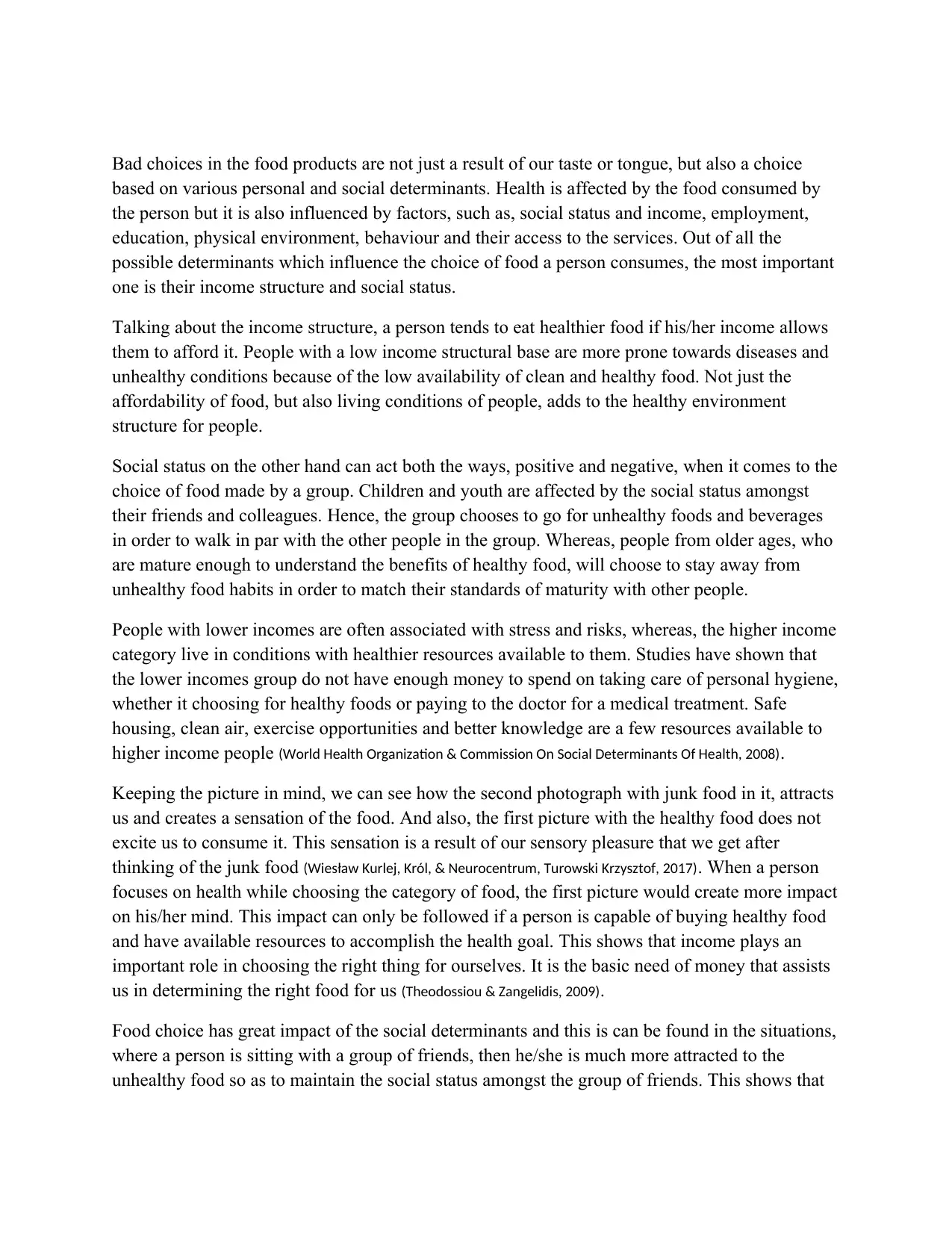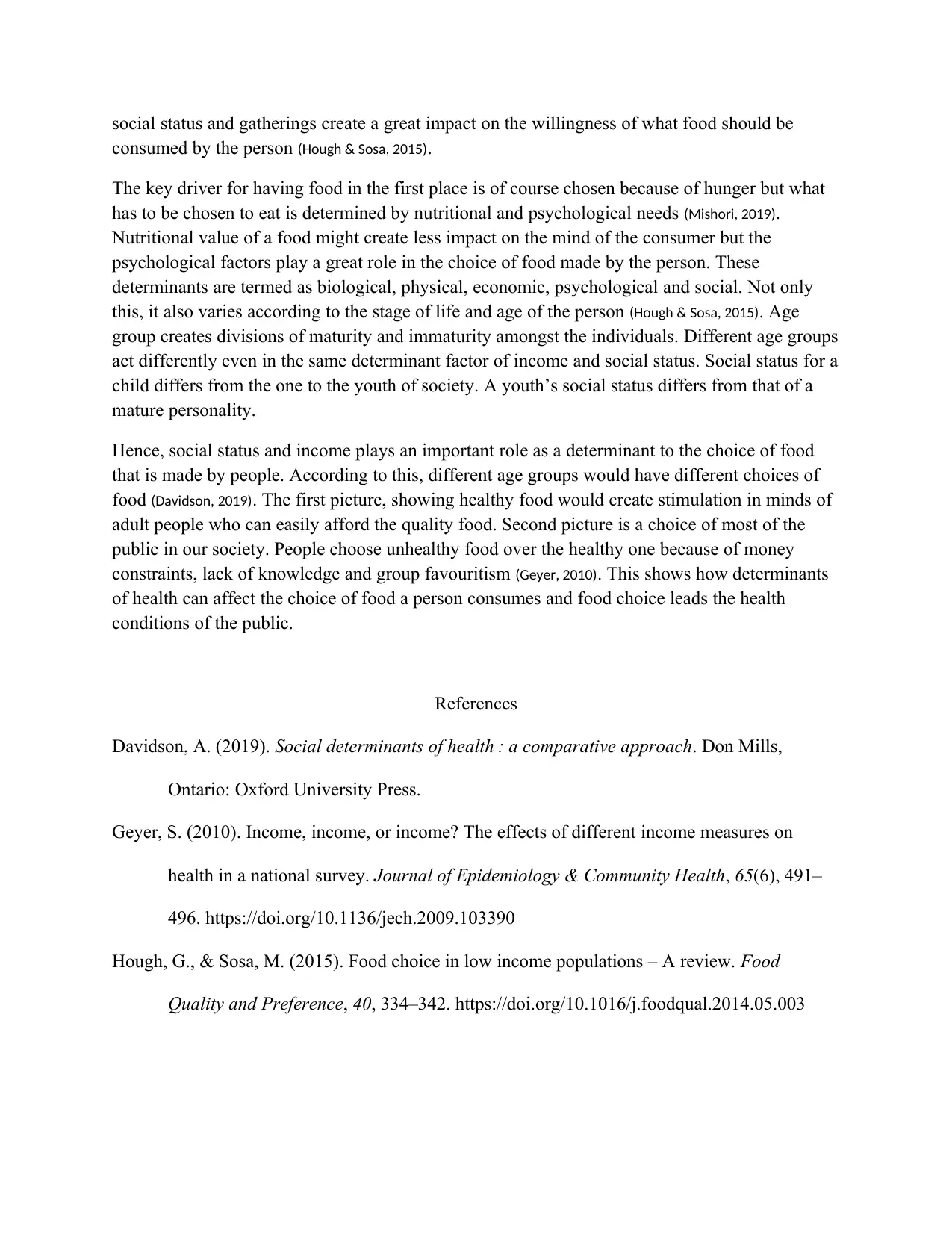Photo Essay: Exploring Health Determinants Impacting Food Choices
VerifiedAdded on 2022/09/30
|4
|1227
|236
Essay
AI Summary
This photo essay delves into the complex relationship between health determinants and food choices. It argues that factors such as income and social status significantly influence dietary habits, often leading to disparities in health outcomes. The essay highlights how individuals with lower incomes may have limited access to healthy food options and are more susceptible to health risks. Conversely, those with higher incomes often benefit from healthier resources and environments. The essay also examines the impact of social status, particularly among youth, where peer influence can lead to unhealthy food choices. Through analysis and references, it underscores the need to address these social determinants to improve public health and promote equitable access to nutritious food for all. It also touches upon the psychological and nutritional factors that drive food preferences, emphasizing the importance of understanding these determinants for promoting healthier lifestyles.

NAME OF THE STUDENT
NAME OF THE COLLEGE
PHOTO ESSAY
“BAD FOOD CHOICES”
NAME OF THE COLLEGE
PHOTO ESSAY
“BAD FOOD CHOICES”
Paraphrase This Document
Need a fresh take? Get an instant paraphrase of this document with our AI Paraphraser

Bad choices in the food products are not just a result of our taste or tongue, but also a choice
based on various personal and social determinants. Health is affected by the food consumed by
the person but it is also influenced by factors, such as, social status and income, employment,
education, physical environment, behaviour and their access to the services. Out of all the
possible determinants which influence the choice of food a person consumes, the most important
one is their income structure and social status.
Talking about the income structure, a person tends to eat healthier food if his/her income allows
them to afford it. People with a low income structural base are more prone towards diseases and
unhealthy conditions because of the low availability of clean and healthy food. Not just the
affordability of food, but also living conditions of people, adds to the healthy environment
structure for people.
Social status on the other hand can act both the ways, positive and negative, when it comes to the
choice of food made by a group. Children and youth are affected by the social status amongst
their friends and colleagues. Hence, the group chooses to go for unhealthy foods and beverages
in order to walk in par with the other people in the group. Whereas, people from older ages, who
are mature enough to understand the benefits of healthy food, will choose to stay away from
unhealthy food habits in order to match their standards of maturity with other people.
People with lower incomes are often associated with stress and risks, whereas, the higher income
category live in conditions with healthier resources available to them. Studies have shown that
the lower incomes group do not have enough money to spend on taking care of personal hygiene,
whether it choosing for healthy foods or paying to the doctor for a medical treatment. Safe
housing, clean air, exercise opportunities and better knowledge are a few resources available to
higher income people (World Health Organization & Commission On Social Determinants Of Health, 2008).
Keeping the picture in mind, we can see how the second photograph with junk food in it, attracts
us and creates a sensation of the food. And also, the first picture with the healthy food does not
excite us to consume it. This sensation is a result of our sensory pleasure that we get after
thinking of the junk food (Wiesław Kurlej, Król, & Neurocentrum, Turowski Krzysztof, 2017) . When a person
focuses on health while choosing the category of food, the first picture would create more impact
on his/her mind. This impact can only be followed if a person is capable of buying healthy food
and have available resources to accomplish the health goal. This shows that income plays an
important role in choosing the right thing for ourselves. It is the basic need of money that assists
us in determining the right food for us (Theodossiou & Zangelidis, 2009).
Food choice has great impact of the social determinants and this is can be found in the situations,
where a person is sitting with a group of friends, then he/she is much more attracted to the
unhealthy food so as to maintain the social status amongst the group of friends. This shows that
based on various personal and social determinants. Health is affected by the food consumed by
the person but it is also influenced by factors, such as, social status and income, employment,
education, physical environment, behaviour and their access to the services. Out of all the
possible determinants which influence the choice of food a person consumes, the most important
one is their income structure and social status.
Talking about the income structure, a person tends to eat healthier food if his/her income allows
them to afford it. People with a low income structural base are more prone towards diseases and
unhealthy conditions because of the low availability of clean and healthy food. Not just the
affordability of food, but also living conditions of people, adds to the healthy environment
structure for people.
Social status on the other hand can act both the ways, positive and negative, when it comes to the
choice of food made by a group. Children and youth are affected by the social status amongst
their friends and colleagues. Hence, the group chooses to go for unhealthy foods and beverages
in order to walk in par with the other people in the group. Whereas, people from older ages, who
are mature enough to understand the benefits of healthy food, will choose to stay away from
unhealthy food habits in order to match their standards of maturity with other people.
People with lower incomes are often associated with stress and risks, whereas, the higher income
category live in conditions with healthier resources available to them. Studies have shown that
the lower incomes group do not have enough money to spend on taking care of personal hygiene,
whether it choosing for healthy foods or paying to the doctor for a medical treatment. Safe
housing, clean air, exercise opportunities and better knowledge are a few resources available to
higher income people (World Health Organization & Commission On Social Determinants Of Health, 2008).
Keeping the picture in mind, we can see how the second photograph with junk food in it, attracts
us and creates a sensation of the food. And also, the first picture with the healthy food does not
excite us to consume it. This sensation is a result of our sensory pleasure that we get after
thinking of the junk food (Wiesław Kurlej, Król, & Neurocentrum, Turowski Krzysztof, 2017) . When a person
focuses on health while choosing the category of food, the first picture would create more impact
on his/her mind. This impact can only be followed if a person is capable of buying healthy food
and have available resources to accomplish the health goal. This shows that income plays an
important role in choosing the right thing for ourselves. It is the basic need of money that assists
us in determining the right food for us (Theodossiou & Zangelidis, 2009).
Food choice has great impact of the social determinants and this is can be found in the situations,
where a person is sitting with a group of friends, then he/she is much more attracted to the
unhealthy food so as to maintain the social status amongst the group of friends. This shows that

social status and gatherings create a great impact on the willingness of what food should be
consumed by the person (Hough & Sosa, 2015).
The key driver for having food in the first place is of course chosen because of hunger but what
has to be chosen to eat is determined by nutritional and psychological needs (Mishori, 2019).
Nutritional value of a food might create less impact on the mind of the consumer but the
psychological factors play a great role in the choice of food made by the person. These
determinants are termed as biological, physical, economic, psychological and social. Not only
this, it also varies according to the stage of life and age of the person (Hough & Sosa, 2015). Age
group creates divisions of maturity and immaturity amongst the individuals. Different age groups
act differently even in the same determinant factor of income and social status. Social status for a
child differs from the one to the youth of society. A youth’s social status differs from that of a
mature personality.
Hence, social status and income plays an important role as a determinant to the choice of food
that is made by people. According to this, different age groups would have different choices of
food (Davidson, 2019). The first picture, showing healthy food would create stimulation in minds of
adult people who can easily afford the quality food. Second picture is a choice of most of the
public in our society. People choose unhealthy food over the healthy one because of money
constraints, lack of knowledge and group favouritism (Geyer, 2010). This shows how determinants
of health can affect the choice of food a person consumes and food choice leads the health
conditions of the public.
References
Davidson, A. (2019). Social determinants of health : a comparative approach. Don Mills,
Ontario: Oxford University Press.
Geyer, S. (2010). Income, income, or income? The effects of different income measures on
health in a national survey. Journal of Epidemiology & Community Health, 65(6), 491–
496. https://doi.org/10.1136/jech.2009.103390
Hough, G., & Sosa, M. (2015). Food choice in low income populations – A review. Food
Quality and Preference, 40, 334–342. https://doi.org/10.1016/j.foodqual.2014.05.003
consumed by the person (Hough & Sosa, 2015).
The key driver for having food in the first place is of course chosen because of hunger but what
has to be chosen to eat is determined by nutritional and psychological needs (Mishori, 2019).
Nutritional value of a food might create less impact on the mind of the consumer but the
psychological factors play a great role in the choice of food made by the person. These
determinants are termed as biological, physical, economic, psychological and social. Not only
this, it also varies according to the stage of life and age of the person (Hough & Sosa, 2015). Age
group creates divisions of maturity and immaturity amongst the individuals. Different age groups
act differently even in the same determinant factor of income and social status. Social status for a
child differs from the one to the youth of society. A youth’s social status differs from that of a
mature personality.
Hence, social status and income plays an important role as a determinant to the choice of food
that is made by people. According to this, different age groups would have different choices of
food (Davidson, 2019). The first picture, showing healthy food would create stimulation in minds of
adult people who can easily afford the quality food. Second picture is a choice of most of the
public in our society. People choose unhealthy food over the healthy one because of money
constraints, lack of knowledge and group favouritism (Geyer, 2010). This shows how determinants
of health can affect the choice of food a person consumes and food choice leads the health
conditions of the public.
References
Davidson, A. (2019). Social determinants of health : a comparative approach. Don Mills,
Ontario: Oxford University Press.
Geyer, S. (2010). Income, income, or income? The effects of different income measures on
health in a national survey. Journal of Epidemiology & Community Health, 65(6), 491–
496. https://doi.org/10.1136/jech.2009.103390
Hough, G., & Sosa, M. (2015). Food choice in low income populations – A review. Food
Quality and Preference, 40, 334–342. https://doi.org/10.1016/j.foodqual.2014.05.003
⊘ This is a preview!⊘
Do you want full access?
Subscribe today to unlock all pages.

Trusted by 1+ million students worldwide

Mishori, R. (2019). The Social Determinants of Health? Time to Focus on the Political
Determinants of Health! Medical Care, 1.
https://doi.org/10.1097/mlr.0000000000001131
Theodossiou, I., & Zangelidis, A. (2009). The social gradient in health: The effect of absolute
income and subjective social status assessment on the individual’s health in
Europe. Economics & Human Biology, 7(2), 229–237.
https://doi.org/10.1016/j.ehb.2009.05.001
Wiesław Kurlej, Król, H., & Neurocentrum, Turowski Krzysztof. (2017). Health and its
determinants. Lublin: Wydawnictwo Naukowe Neurocentrum.
World Food Programme. (2007). Hunger and health. London ; Sterling, Va: Earthscan.
World Health Organization, & Commission On Social Determinants Of Health.
(2008). CLOSING the gap in a generation : health equity through action on the social
determinants of health. Geneva: World Health Organization.
Determinants of Health! Medical Care, 1.
https://doi.org/10.1097/mlr.0000000000001131
Theodossiou, I., & Zangelidis, A. (2009). The social gradient in health: The effect of absolute
income and subjective social status assessment on the individual’s health in
Europe. Economics & Human Biology, 7(2), 229–237.
https://doi.org/10.1016/j.ehb.2009.05.001
Wiesław Kurlej, Król, H., & Neurocentrum, Turowski Krzysztof. (2017). Health and its
determinants. Lublin: Wydawnictwo Naukowe Neurocentrum.
World Food Programme. (2007). Hunger and health. London ; Sterling, Va: Earthscan.
World Health Organization, & Commission On Social Determinants Of Health.
(2008). CLOSING the gap in a generation : health equity through action on the social
determinants of health. Geneva: World Health Organization.
1 out of 4
Related Documents
Your All-in-One AI-Powered Toolkit for Academic Success.
+13062052269
info@desklib.com
Available 24*7 on WhatsApp / Email
![[object Object]](/_next/static/media/star-bottom.7253800d.svg)
Unlock your academic potential
Copyright © 2020–2025 A2Z Services. All Rights Reserved. Developed and managed by ZUCOL.





